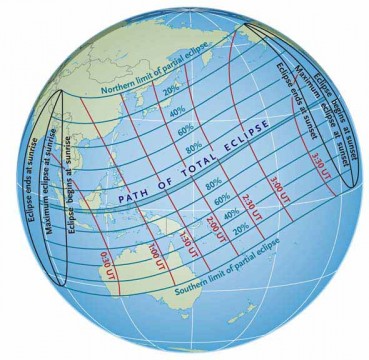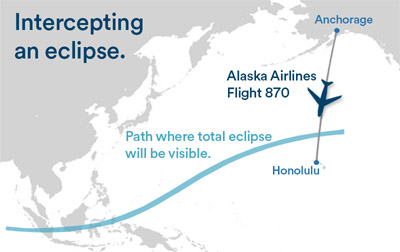On March 9th — late on Tuesday, March 8th, in the U.S. — the Moon will completely cover the Sun. Check here for the links you'll need to see this celestial spectacle as it happens.
Right now I wish I were enjoying the balmy warmth of Indonesia. On March 9th, the Moon will glide across the Sun's disk and create a total solar eclipse, and the path of totality makes landfall only on parts of Sumatra, Borneo, Sulawesi, and tiny bits of Micronesia. So, for the first time since 2001, I'm going to miss standing in the Moon's shadow.
Fortunately, technological resources exist now that weren't available back then. Two groups are planning to webcast the event live. My almanac tells me that Indonesia will experience roughly 3½; minutes of totality at around 1:00 Universal Time on March 9th, which is mid- to late morning in Indonesia.
But if you live in the Western Hemisphere, don't try checking out the eclipse that day. Due to the International Date Line, the eclipse occurs late on March 8th here in the U.S.
Here are the links to those webcasts:
Exploratorium Webcast: The staff of San Francisco's Exploratorium is collaborating with NASA and the National Science Foundation to produce a live broadcast of the total solar eclipse. They've sent a production crew thousands of miles by plane and by boat to Woleai, Micronesia. (You can read the expedition's blogs here.) You can watch a 3¼-hour-long telescope feed beginning on the 8th at 4:00 p.m. PST (7:00 p.m. EST, 0:00 Universal Time on the 9th), and narrated webcast beginning an hour later.
Slooh Webcast: The Slooh online observatory has also dispatched astronomer Paul Cox on a wild expedition to the remote countryside of Indonesia to webcast the eclipse. His 3-hour-long livestream begins on the 8th at 3:00 p.m. PST (6:00 p.m. EST, 23:00 UT). Cox will be joined during the event by Slooh astronomer and veteran astronomy writer Bob Berman.
Many eclipse-chasers are making the long journey to see the event firsthand. In addition to a congregation in Ternate, at least six cruise ships and two aircraft will moving into position. Another group is setting up on Woleai Atoll in Micronesia, which is closest to the location where the eclipse will be greatest (predicted to be 4 minutes 9 seconds long at 1:57 Universal Time).

S&T diagram; source: Fred Espenak
You can see the track of totality in the map at right. The red lines show when the eclipse is greatest in Universal Time on March 9th. (But remember: the event occurs late on March 8th in the Americas.) Interpolate between the blue lines to see what percent of the Sun's diameter the Moon will cover at that time.
Indonesia's day-to-day weather is heavily influenced by the Inter-Tropical Convergence zone, and those hoping for clear skies are at the mercy of a humid, unstable atmosphere with frequent clouds and heavy rain. Weather prospects improve along the track to the northeast, but meteorologist Jay Anderson predicts that nowhere is the chance of clear skies any better than about 50%.
That said, reports reaching Sky & Telescope suggest that weather prospects are generally quite good, and those who've traveled so far to see the event are hopeful for clear skies.
One group that won't have to worry about clouds is heading for the Moon's shadow in a most unorthodox way. The 163 passengers aboard Alaska Airlines flight 870 will see the event from a point 695 miles north of Honolulu. The Moon-blocked-Sun will be close to setting and low enough to be observable out the plane's starboard windows.

Alaska Airlines
This coincidental meeting in the sky didn't just happen by coincidence. About a year ago, meteorologist and devoted eclipse-chaser Joe Rao noticed that the flight's timing was "just about right," and he mounted a one-man campaign to get the airline to agree to adjust the flight's departure so that the Boeing 737-800 would be in the right place at the right time. Now it's a Big Deal, and Alaska Airlines even has a second aircraft ready as a backup.
Meanwhile, the eclipse will be partial for a much wider area, including Southeast Asia, China, Japan, and parts of Australia. Those in Manila, the Philippines, get to see 47% of the Sun's disk covered. In Honolulu, it's 63% — but because of the International Date Line, Hawai'ians see the event on the afternoon of March 8th (maximum eclipse at 5:37 p.m. HST).
For more maps and further details, see EclipseWise.com.
 3
3
Comments
NS
March 5, 2016 at 8:25 pm
I'm hoping to see the partial eclipse from my home near Honolulu. The weather forecast looks marginal (partly cloudy/cloudy with showers). I have a pinhole mirror to project an image of the sun onto the wall in my bedroom. Is there any way to upload a photo if things work out?
You must be logged in to post a comment.
March 8, 2016 at 6:30 am
we are now in the territory of Indonesia, Central Sulawesi, housed in Natabaru, to witness the solar eclipse precisely tomorrow on 09 March 2016
my position 0°55'50.9"S 119°59'41.9"E
You must be logged in to post a comment.
NS
March 9, 2016 at 3:05 am
The weather near Honolulu was cloudy and breezy, with occasional showers. I got a couple of quick naked-eye glimpses of the eclipse, but not enough time to line up the mirror or take any photos. Oh well...
You must be logged in to post a comment.
You must be logged in to post a comment.